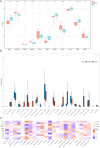Identification of a disulfidptosis-related genes signature for diagnostic and immune infiltration characteristics in cervical cancer
- PMID: 40305445
- PMCID: PMC12043181
- DOI: 10.1371/journal.pone.0322387
Identification of a disulfidptosis-related genes signature for diagnostic and immune infiltration characteristics in cervical cancer
Abstract
Background: Cervical cancer (CC) ranks as the fourth most common malignancy affecting women globally, with research highlighting a rising incidence among younger age groups. Disulfidptosis, a newly identified form of regulated cell death, has been implicated in the pathogenesis of numerous diseases. This study employs bioinformatics analyses to explore the expression profiles and functional roles of disulfidptosis-related genes (DRGs) in the context of cervical cancer.
Methods: Differential analysis of the gene expression matrix in CC was performed to identify differentially expressed genes. The overlap between these genes and disulfidptosis-related genes was then determined. Key hub genes were identified using multiple machine learning approaches, including LASSO regression, support vector machines (SVM), and random forest (RF). These hub genes were subsequently used to construct a predictive model, which was validated using external datasets to ensure robustness and reliability.
Results: In this study, 11 overlapping genes were identified, among which four hub genes-BRK1, NDUFA11, RAC1, and NDUFS1-were extracted using machine learning techniques. The diagnostic performance of these hub genes was validated with external datasets, and a predictive model was constructed based on their expression. The model demonstrated an exceptionally high area under the curve (AUC) of 0.997. Moreover, AUC values exceeding 0.85 for two independent validation datasets further confirmed the model's accuracy and stability. Notably, NDUFA11 and BRK1 showed significant associations with patient survival, highlighting their prognostic importance in cervical squamous cell carcinoma. Using CMAP and DGIdb databases, Metformin and Coenzyme-I were identified as potential targeted therapies for NDUFS1 and NDUFA11, respectively, offering new therapeutic avenues for patients.
Conclusion: This study uncovered a strong association between disulfidptosis and CC and developed a predictive model to assess the risk in CC patients. These findings offer novel insights into identifying biomarkers and potential therapeutic targets for CC, paving the way for improved diagnostic and treatment strategies.
Copyright: © 2025 Zhou et al. This is an open access article distributed under the terms of the Creative Commons Attribution License, which permits unrestricted use, distribution, and reproduction in any medium, provided the original author and source are credited.
Conflict of interest statement
The authors have declared that no competing interests exist.
Figures







Similar articles
-
Integrated bioinformatics combined with machine learning to analyze shared biomarkers and pathways in psoriasis and cervical squamous cell carcinoma.Front Immunol. 2024 May 28;15:1351908. doi: 10.3389/fimmu.2024.1351908. eCollection 2024. Front Immunol. 2024. PMID: 38863714 Free PMC article.
-
Unraveling pathogenesis, biomarkers and potential therapeutic agents for endometriosis associated with disulfidptosis based on bioinformatics analysis, machine learning and experiment validation.J Biol Eng. 2024 Jul 26;18(1):42. doi: 10.1186/s13036-024-00437-0. J Biol Eng. 2024. PMID: 39061076 Free PMC article.
-
Target oxidative stress-induced disulfidptosis: novel therapeutic avenues in Parkinson's disease.Mol Brain. 2025 Apr 4;18(1):29. doi: 10.1186/s13041-025-01200-2. Mol Brain. 2025. PMID: 40186271 Free PMC article.
-
Advances in the study of disulfidptosis in digestive tract tumors.Discov Oncol. 2025 Feb 15;16(1):186. doi: 10.1007/s12672-025-01875-y. Discov Oncol. 2025. PMID: 39954025 Free PMC article. Review.
-
Disulfidptosis, A Novel Cell Death Pathway: Molecular Landscape and Therapeutic Implications.Aging Dis. 2024 May 2;16(2):917-945. doi: 10.14336/AD.2024.0083. Aging Dis. 2024. PMID: 38739940 Free PMC article. Review.
References
MeSH terms
Substances
LinkOut - more resources
Full Text Sources
Medical
Research Materials
Miscellaneous

